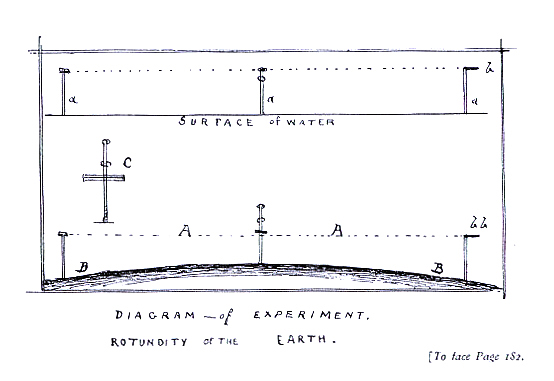|
Russel Wallace : Alfred Russell Wallace (sic)
"The Dell, Grays, Essex, April 20th, 1874. "Dear Sir,-- Parallax, whose proper name is Rowbotham, is not the man whose wager I accepted. He is far too clever for that; Hampden was one of his dupes. Parallax makes the boldest false statements, and as the number of those who can contradict him from actual experience is small, his assertions are believed by thousands. As an example, in a recent correspondence with him he maintained that it is a property of the Telescope to show objects depressed below objects less distant, which are really in a line with them! This was to account for the admitted fact that in [[p. 182]] my experiment the centre signal appeared about 5 feet above the distant one, although at the same height above the water. Thus: (See diagram opposite.) [[unnumbered page facing page 182]]
[[p. 182]] a,a,a signal staffs, three miles apart, and 13 feet out of the water. b, the telescope; c, the distant signal, 6 miles off, showing the appearance seen in the telescope; the lower disc in the middle signal was 4 feet below the top--enabling the observer to estimate the amount of depression of the distant signal, which appeared as shown in the lower diagram as at AA--the visual line from the telescope--b,b,--the signals being 3 miles apart. BB represents the surface of the water on the Earth. The unprincipled character of the man is shown by his admitting that in my case the middle signal appeared elevated, and calling in the aid of a supposed property of the telescope to account for it, while in his lecture he maintains that it does not appear elevated. As to the Ordnance Surveyors, I have no doubt there is a rule that they are to make no allowance for curvature, because they are not allowed any but very short sights.1 The reason of the rule is obvious; if the surveyors were allowed to think that, making allowance for curvature, long sights were as good as short ones, they would be liable to great errors, especially those arising from unequal refraction. I wonder at these lectures his gross false statements are not exposed; but I suppose there are always a majority present so ignorant as to believe that his assertions are as good as any one's. The Field newspaper for March 26, 1870, contains a full report of my experiments, with diagrams, and for some weeks before and after there are articles and correspondence on the subject. I remain, Yours very truly, P.S.--If you come to Grays I shall be happy to see you." Sometime afterwards I called at the Dell, Grays, and had an interview with Mr. Wallace.
|

